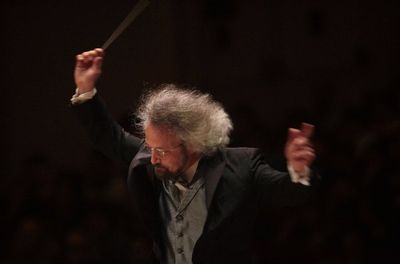The Power of Festivals
In my idealistic youth, nothing frustrated me more than jaded orchestral musicians. When so many people make their livings in menial and exhausting ways, how can we complain about playing Brahms and Mozart? Being a musician is hard work that comes after years of dedicated preparation — but it still “beats digging ditches,” as my father used to say. (He knew whereof he spoke, having dug actual ditches in the Arkansas heat in 1959 or so. I try to remind myself frequently that he worked most of his life in the hope that I would never have to know what that felt like. Thanks, Dad.)
The reality, though, is that orchestral life is a grind. From week to week, as music rotates through the folders and different conductors drift across the podium, players can start to feel like cogs in a giant machine. Laying down whole-notes behind a rock singer or playing the umpteenth Light Cavalry Overture in a children’s concert can feel like working on an assembly line. And even the greatest masterworks can get to be a drag with a so-so conductor or an inattentive audience. It ain’t the way things ought to be, but sometimes it’s the way things are.
Which is why the growing trend of orchestras presenting festivals around a single composer or other theme is so invigorating. The routine is broken, and for a few days or a few weeks, everybody rallies around a common focal point. Audience, critics, players, and conductor all share a kind of euphoric burst of energy and a community conversation begins.
The San Antonio Symphony‘s recent Tchaikovsky Festival had exactly that kind of effect. The orchestra played all six symphonies and both piano concertos in four concerts over two weekends. That concentration and focus yielded powerful results: in the finale of the Fourth Symphony during the first weekend, for example, the strings produced a focused, weighty sound in their flying sixteenth-note runs that was exhilarating. Throughout the festival, a palpable sense of passion and abandon was in the air. Here’s hoping that next year’s Beethoven Festival, which will involve more concerts and a wider range of San Antonio performers, will be similarly compelling. It looks promising!
Over the last week or so, an even more fascinating festival experience unfolded at Carnegie Hall. Spring for Music presented seven different North American orchestras playing innovative programs at affordable prices. Because the Spring for Music concerts were nationally broadcast on American Public Media’s Classical Live, people all over were able to be a part of the vibe.
There were several wonderful programs and performances this week, but the standout was the Oregon Symphony‘s May 12 wartime journey through music of questioning and conflict. All four pieces on the program are great masterworks:
- Charles Ives: The Unanswered Question
- John Adams: The Wound-Dresser (with baritone Sanford Sylvan)
- Benjamin Britten: Sinfonia da Requiem
- Ralph Vaughan Williams: Symphony No. 4
The masterstroke, though, was Music Director Carlos Kalmar’s decision to play the first three pieces without pause, making the first half of the concert into one continuous flow. I can’t overstate the brilliance of this: the moment when The Unanswered Question dissolved seamlessly into The Wound-Dresser gave me chills that I will probably never forget.
And then there was the playing: world-class. I was so blown away by the richness and control of the orchestra that I took to Twitter to see if I was the only one so powerfully struck by the awesomeness. I wasn’t. Moments after the concert ended, New Yorker critic Alex Ross tweeted: “Triumphant Carnegie debut for the Oregon Symphony — best of Spring for Music so far.”
Oregon Symphony violist (and my old friend) Charles Noble blogs regularly, and his morning-after post beautifully sums up what a festival experience can mean when all the stars align:
We quite frankly nearly blew the roof off of the place. It was a moment that was long in coming. It was built not just in the last eight years since Carlos arrived as our music director, though it’s undeniable that his impact on the artistic health of the organization has been positively huge. But before Carlos, there were generations of dedicated musicians and the previous music directors, and managers, and support staff. They, too, all made last night possible.
We were also, as an orchestra and as an organization, ready for this trip. We were in the perfect position to make the maximum impact. We have thrown a rock into the pond that will send ripples out for the foreseeable future. The little orchestra that could came and did. We not only punched above our weight, we k.o.’d the heavyweight champ.
You want to hear this concert now, right? The beauty of Spring for Music is that you can — just click here and prepare to be astonished.


Thank you for introducing me to this new concept of a festival. I tend to think of festivals in terms of summer festivals, which sometimes can be a lot of fun and other times (like when the weather is not cooperating) quite the drag. The Tchaik festival sounds like it was a lot of fun.
Thanks again!
May 15, 2011 at 11:21 pm